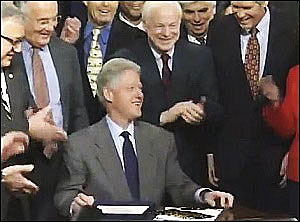 Thanks to the Presidential debates, most Americans have heard of the Glass-Steagall Act which kept the country’s banking system safe for 66 years until it was repealed by President Bill Clinton in 1999, allowing the risky activities of Wall Street trading firms to merge with insured-deposit banks, setting the stage for the Wall Street collapse in 2008. But few Americans have ever heard of the Riegle-Neal Interstate Banking and Branching Efficiency Act of 1994, which Bill Clinton signed into law less than two years after taking office. The Riegle-Neal legislation allowed bank holding companies to acquire banks anywhere in the nation and invalidated the laws of 36 states which had allowed interstate banking only on a reciprocal or regional basis.
Thanks to the Presidential debates, most Americans have heard of the Glass-Steagall Act which kept the country’s banking system safe for 66 years until it was repealed by President Bill Clinton in 1999, allowing the risky activities of Wall Street trading firms to merge with insured-deposit banks, setting the stage for the Wall Street collapse in 2008. But few Americans have ever heard of the Riegle-Neal Interstate Banking and Branching Efficiency Act of 1994, which Bill Clinton signed into law less than two years after taking office. The Riegle-Neal legislation allowed bank holding companies to acquire banks anywhere in the nation and invalidated the laws of 36 states which had allowed interstate banking only on a reciprocal or regional basis.
Put these two pieces of legislation together with the Commodity Futures Modernization Act of 2000, also signed into law by Bill Clinton, which allowed trillions of dollars of OTC derivatives on Wall Street to escape regulation, and you have just defined America’s current banking system from hell.
In 1934, there were 14,146 commercial banks with FDIC insurance in the United States. By 1985, that number had barely budged – we had a total of 14,417. But as of this month, we have 6,172 FDIC-insured commercial banks, a decline of 57 percent, with the annual declines accelerating after the passage of Riegle-Neal in 1994.
This post was published at Wall Street On Parade By Pam Martens and Russ Marte.

 Follow on Twitter
Follow on Twitter
Recent Comments